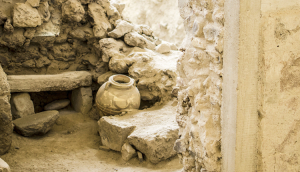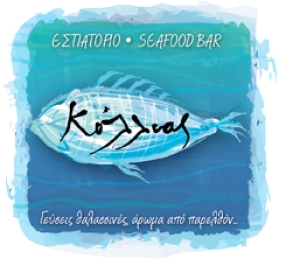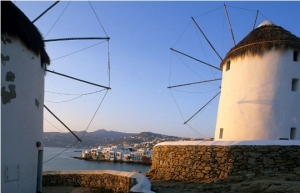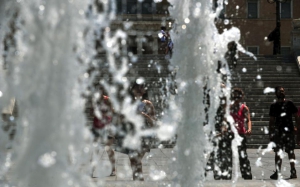Ingredients:
3 cups of double cream or whipping cream
3 cups of full fat milk
1 1/8 cups of sugar
3 teaspoons of salep (level)
7/8 - 1 teaspoon of golden gum mastic, ground (see below)
Preparation:
Grind the mastic: Mastic is usually sold in drops of resin which can stick to the mortar and pestle during grinding. To avoid, freeze mastic for 15 minutes before using and place it along with 1-2 tablespoons of the sugar in the mortar. Grind with the pestle.
In a mixing bowl, beat 1/2 cup of the milk with the ground mastic (and sugar used to grind) until completely blended. Dissolve the salepi in 1/2 cup of cold milk. Warm the remaining milk in a saucepan over low heat. Beating the mastic mixture at high speed, add the warm milk, then the dissolved salepi. Add remaining sugar and cream.
Transfer the mixture to a saucepan and boil over low heat for about 20 minutes, stirring frequently to prevent sticking and clumping. Remove from heat and set aside to cool to room temperature.
Ice cream maker: When cooled, transfer to ice cream maker and freeze according to manufacturer's instructions.
Without ice cream maker: Transfer to a metal container, cover with tightly fitting lid or foil and place in freezer. Every half hour, remove from freezer, transfer to a mixing bowl and beat with a hand mixer until frothy. Quickly place back in the metal container and put in the freezer. Repeat three more times.
Remove from freezer 10 minutes before serving.
Serve alone, with a syrup topping or spoon sweet, and sprinkle with chopped almonds. Kaimaki is also served with syrupy sweets like karythopita (Greek walnut cake).
Note about buying salepi: The most common form available has been premixed with sugar and other additives. The best salepi for this recipe is the pure ground orchid root if you can find it. If not, use 4-5 times the amount of salepi called for in the recipe and decrease the sugar to 1 cup.
By Nancy Gaifyllia
XpatAthens
New Year Wishes & Traditions
Smithsonian Magazine Cover Story: The Legacy of Philip II of Macedon
To read this aricle in full, please visit: greece-is.com
Archaeological Finds Discovered During The Covid19-Era In Greece
This list explores 3 of the most significant archaeological finds reported in Greece over the past months.
1. Theopetra Cave, Thessaly
Theopetra Cave in Thessaly is a significant site that was continuously occupied by humans for 130,000 years. The cave is famous for the fossilized footprints of a group of young Neanderthals and a 23,000-year-old wall one of the oldest known human constructions. Excavations at Theopetra have also revealed the well-preserved remains of a young woman, named Avgi who lived in the cave during the Mesolithic period, around 7000 BC.
The results of the analysis of the most recent finds reveal even more clues about the lifestyle and diet of the cave’s later Neolithic inhabitants. In fact, the evidence shows that Stone Age Greeks ate a healthier diet than many modern humans. The inhabitants of the cave ate wheat, barley, olives, and pulses, and a moderate amount of meat from a mix of domesticated and wild animals such as wild boar. Evidence suggests the people in Theopetra Cave kept cattle, pigs, sheep, goats, and at least one dog, perhaps as a companion for hunting and herding.
2. Aiolou Street, Athens
A well-preserved head of a statue depicting the god Hermes was discovered lying a mere 1.3 m under street level last November during construction works on the busy Aiolou Street in central Athens. The head is thought to have formed part of a herma (literally meaning ‘heap of stones’), one of many similar statues that functioned as road markers or indicators of important public or private spaces in ancient Athens.
Based on its style, the newly found bust dates to around the end of the 4th or the beginning of the 3rd century BC and resembles the bearded Hermes Propylaios famously sculpted by Alcamenes who is considered by many as one of the finest sculptors in ancient Greece. Its unearthing is a reminder that Athens is still packed with hidden archaeological treasures waiting to be discovered.
3. Akrotiri, Santorini
Santorini’s strategic position on the maritime routes connecting southern Cyclades, Crete, and the copper-rich island of Cyprus was one of the reasons why it became an important trade center during the Middle Bronze Age between 2160 and 1600 BC.
In early 2020, Professor Christos Doumas reported on new archaeological finds discovered during excavations at the famous settlement of Akrotiri. Among the finds in the interior of a building known as the ‘House of Thrania’ (‘House of Benches’) were two large double-headed axes made of finely-crafted bronze plates; artifacts that are typical of Minoan culture and religion in Crete and the southern Aegean. A large number of miniature ceramic vessels, other bronze items, and fragments of jewelry, including a small bead of rock crystal carved in the shape of a figure-of-eight shield were also found.
The most remarkable discovery was an inscription in Linear A, the undeciphered writing system used by the Minoans, on a fragment of what would have been a wooden construction, perhaps a box or chest. These finds gave more insight into the life of the settlers of the Bronze Age town before the Theran eruption in 1628 BC, one of the largest and most catastrophic volcanic eruptions in Mediterranean history.
To read this article in full and discover the full list of significant discoveries, please visit: greece-is.com
Athens Presents: Project Athena
XpatAthens extends a warm thank you to This Is Athens and the City Of Athens for sharing news and inspiring stories about how Athens aspires to be a clean, friendly, and welcoming city to live in.
Unlocking Hidden Business Resources: A Fresh Perspective
Why it matters: Protecting and monetizing innovations can provide long-term financial benefits and market security.
My Week in Athens… April 12
Springtime weather has everyone outside… The week’s tragedy was fresh in everyone’s mind – but still something about the sunshine, the fresh air and the families outside made Saturday a ‘good day’…
I spent the afternoon learning about the past – the ancient past on display at the National Archeological Museum of Athens.
I know, I know - I figured I knew as much as one needed to know about ‘all that stuff’… I mean, it’s kind of everywhere in Athens. Well, was I ever wrong.
This time, we were lucky to be escorted through the museum by a professional Guide (friend of a friend of a friend…). This made all the difference. She knew the history, the symbolism, the cultural realities, the archeological controversies, the stories, the myths, the regional contexts, the social customs, the religious background – and anything else we cared to ask her about! For the first time, the rocks and the statues really came alive. There is really so much there to take in – the richness of the Hellenic past cannot be comprehended just by walking around and reading the little descriptive paragraphs alongside the endless rows of statues…
And what’s more, we got to see the brand new exhibit of the Antikythera Shipwreck, the sunken treasures of a 2nd century BC cargo ship. This is a really cool display (both in content and in concept!), and includes the Antikythera Mechanism – what some are calling the first ‘computer’.
All of that for the 7euro admission charge (Guide extra!) – not bad for a Saturday afternoon. And totally worth the visit.
National Archeological Museum
44 Patission Street
http://www.namuseum.gr/wellcome-en.html
See you next week.
Jack
In this weekly space, keep up with ‘Jack’ as he navigates daily life in Athens… Anecdotes, stories, hits & misses, the good, the bad and, well, the rest…
Kollias - Legendary Seafood Now In Syngrou
Years can go by between visits, as was the case with a friend of mine recently, but he recalled her name and the dish she ate the last time she was there! Software geniuses have designed computer programs that do that! For Tasso it’s part of being a good restaurateur. The place hasn’t changed much over the years. It’s live in, filled to the brim with fishing and maritime trinkets. His kitchen is open to the public and always bustling, but a visit to the fridge to see the catch of the day—always directly from fishermen and not from the Ichtyoscala (the wholesale market where the fishing boats come in every morning)—is a must. We love the fact that here we found a whole range of great Lenten fare, including: soupia Yiouvetsi (cuttlefish and pasta) with its ink, eggplant rolls filled with mussels, octopus Stifado (stew). Seskoulodolmades with pligouri (chard dolmas filled with bulgur), and stuffed kolokytholoulouda (zucchini blossoms). Don’t miss the pitaroudia (fried patties) filled with Tarama either. Small fish from the Aitoliko Gulf off western Greece, such as “hovioi” are in season now and Tasso is quick to tell you that the bigger size is called “Papoutsia” ("shoes") by local fishermen. We loved his fried small soupies in their ink and the classic but delicious fish baked in salt. It’s not easy in these tough times to keep a place going for so long. Kollia’s recipe for excellent food, fresh greek fish, the best wine prices in town and hospitality that’s really heartfelt has made this place top of my own list of personal favorites.
Hours: Mon-Sat 9pm-1am, Sun noon-4pm; closed Aug
Alcohol Served: Beer, Wine
Ambiance: Intimate, Outdoor Dining
Dress: Business Casual
Meals: Dinner
Reservations: Absolutely Required
Contact: +30 210 462 9620 /210 94 08 620
Address: Syngrou 303 & Dimosthenous
Do you have a recommendation or recipe to share? Send it to us at ideas@xpatathens.com!
The Stone Giants Of The Aegean
The cylindrical landmarks of the Cyclades tell stories of tradition and human labour to the hills which they beautify with their presence. Invented in the pre-industrial times, they give a perfect example of ecology, as they make the best of the Aeolian energy to satisfy man’s need for the cornerstone of nutrition: bread. It was in the 12th and 13th centuries that windmills appeared on Greek land.
Before long they had turned into a favourite topic for writers, painters, and photographers alike. As a matter of fact, more than 600 of them have been installed on the Cycladic archipelago.
To build a wind mill used to be a hard and costly thing. Its spot had to be carefully chosen: the more exposed to northerly winds, the better. That’s why they stand perched on hillsides, and like vigilantes at the exits of gorges, or like lighthouses on the edge of capes. On the other side, the distance to the village was no less important, as wind mills had to be easily accessible by the beasts of burden.
The most common type of wind mills had been the stone built cylindrical ones, with a rotating and following-the-wind conic roof and a straw “hat”. White triangular sails set against some huge antennas would put in motion a system of axes and wheels, which would make a mill stone turn above another mill stone, the latter one still, to grind wheat, barley and corn into flour.
To read more, please see visitgreece.gr
Pagoto Kaimaki: Orchid Ice Cream With Gum Mastic
This fabulous, creamy ice cream calls for gum mastic, that gives it an almost chewy texture, and salep, used as a thickening agent. Both give the ice cream a unique taste. Golden gum mastic from Chios (mastiha) is available through Greek grocers, and salep (salepi, sahlep, sahlab - a powder made from the root of an orchid plant) may be available from Greek, Egyptian, Lebanese, Turkish, or Kosher Markets. This is a smoother preparation than the Turkish dondurma.











